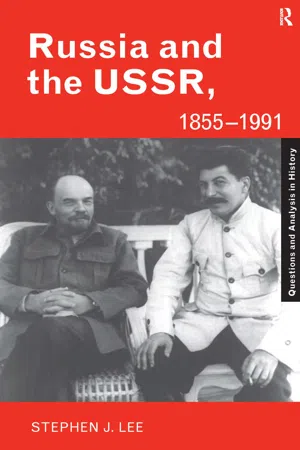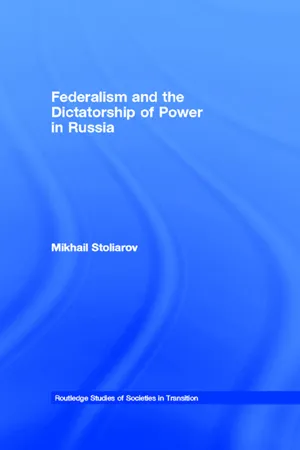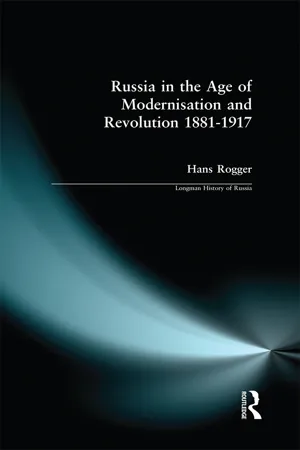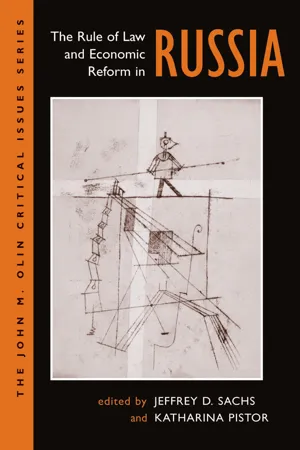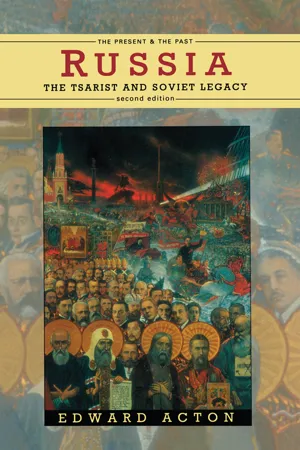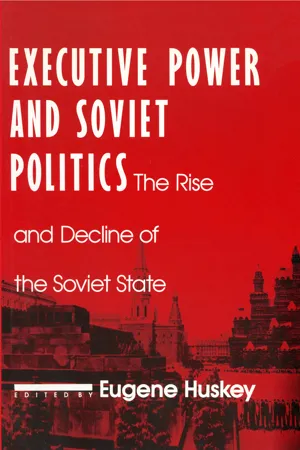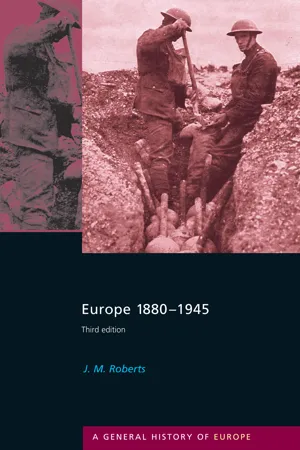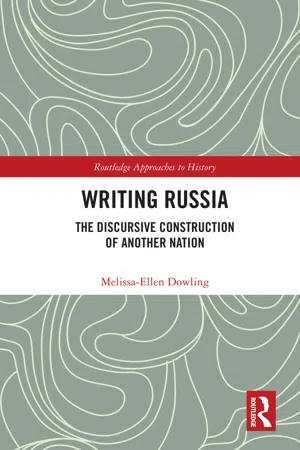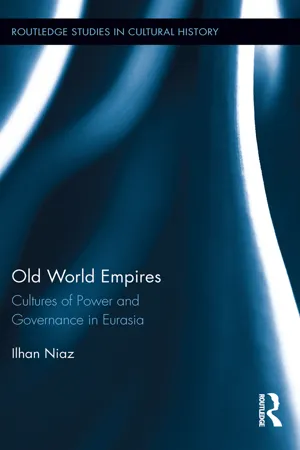History
Tsarist Autocracy
Tsarist autocracy refers to the system of absolute rule by the Russian tsars, who held unchecked power over the state and its people. This form of government was characterized by the tsar's control over all aspects of governance, with no checks and balances from other branches of government or the people. The tsar's authority was often justified by divine right, and dissent was typically suppressed.
Written by Perlego with AI-assistance
Related key terms
11 Key excerpts on "Tsarist Autocracy"
- eBook - ePub
Russia and the USSR, 1855–1991
Autocracy and Dictatorship
- Stephen J. Lee(Author)
- 2020(Publication Date)
- Routledge(Publisher)
IDEOLOGIES AND REGIMESANALYSIS 1: WHAT WERE THE MAIN FEATURES OF THE IDEOLOGIES OF Tsarist Autocracy AND SOVIET COMMUNISM?
During the century and a half since 1850 Russia experienced a wider range of political change than any other European state. Until 1906 the political system was based on autocracy, which survived, in theory if not in practice, until March 1917. Between October 1917 and the end of 1991 the official ideology was Marxism-Leninism, usually referred to as Communism. For a brief period, between March and October 1917, Russia experienced less extreme alternatives in the form of moderate socialism and liberal democracy. Both of these had opposed autocracy but, through their failure to achieve a permanent cooperation after its downfall, let in a system that was to dominate the twentieth century.Tsarist Autocracy
Within the context of Russia, autocracy meant the undiminished and undiluted exercise of the power of the sovereign. The Tsar was an absolute monarch in several senses. Political power came from God and its exercise owed nothing to any elected body; sovereignty was a trust, which was undivided and indivisible. On the other hand, the purpose of power was not the enhancement of the personal interest of the Tsar, since distorted autocracy was the worst form of tyranny. Instead, the Tsar carried a great burden – to uphold the social hierarchy and ensure the welfare of the people. The autocrat had the support of the Russian Orthodox Church, which established a special relationship with the Romanovs and a vital place within the political and social hierarchy.The exercise of the autocratic power varied from Tsar to Tsar. The general pattern of Russian history was either dominance by strong rulers (such as Ivan III, Ivan the Terrible, Michael Romanov, Peter the Great, Catherine the Great and Alexander I) or by political vacuums and weak rulers (such as Peter II, Peter III and Paul). There was very little between the two extremes and the last three Tsars, Alexander II (1855–81), Alexander III (1881–94) and Nicholas II (1894–1914), were particularly conscious of this. They all emphasised their autocratic powers and had others, whether official mentors or strong-willed consorts, to provide constant reminders of their responsibilities. - Mikhail Stoliarov(Author)
- 2003(Publication Date)
- Routledge(Publisher)
Monarchy was not the same as in Europe, not absolute, not constitutional, perhaps … a very autocratic one. Bolshevism that gave the origin to the totalitarian regimes of our century was different from them by the exceptional cruelty to its own population. Even the power of the President of Russia, which considers itself to be democratic, in certain ways surpasses the power of the tsars and Communist leaders by the scope of authority. 22 It is hard to disagree with Mezhuev when he writes about autocracy. Many generations of scholars of Russian history try to resolve the mystery of Russian autocracy. However, one should not think that autocracy is explained by the passion our politicians and rulers have for power. There are plenty of lovers of power in any country! Not a single nation would voluntarily tolerate despotism of the authorities, though genetic submissiveness of the Russian people has become legendary. The patience should, however, not be mistaken for consent. It is often caused by powerlessness to change anything and lack of opportunity and the necessary knowledge of how to do it. Derzhavnost’, the object of our historical study, has a very fertile ground in Russia. The monarch in Russia was always perceived not as a tyrant or dictator, but as “dear father,” as the supreme person in the state, appointed by God over all for the mutual benefit of all. Already in the times of Peter the Great the idea of divine origin of tsar’s power was interpreted as a treaty between the Tsar and the people. According to this treaty, the Tsar was obliged to serve the people, care for their well-being, peaceful living and security. Even in the modern Russia there are many adherents of the autocratic idea of the “father-Tsar who cares for his subjects as for his small children.” A symbiosis of love and devoted service is a part of the Russian national character- H. Rogger(Author)
- 2014(Publication Date)
- Routledge(Publisher)
Chapter TwoTsar, autocrat, and emperorRussian autocracy was not an ancient despotism in which neither law nor custom protected persons and property from a totally arbitrary authority. And compared with the murderous excesses of twentieth-century totalitarianism, pre-revolutionary Russia looks tolerant, even idyllic. After Stalin and Hitler, it appears remarkable that only four of the regicide conspirators of 1881 were hanged and that many more of their comrades of 'The People's Will' were merely imprisoned or exiled. Some, like Vera Figner, survived to become heroes to a new generation of revolutionaries or to rejoin the battle against autocracy.That Russians measured their government by the standards of a less cruel age is but one reason why so many of them found it oppressive, capricious, or unresponsive. They also compared it unfavourably with what they knew of law and politics in the West where the participation of solid citizens in public life was tolerated or encouraged. A Russian professional or landed proprietor who felt as civilized as any European, could hardly be flattered on learning that at the accession of Nicholas II, Turkey, Montenegro, and Russia were the only European countries without a parliament. He could, moreover, judge his government by rules it had laid down for itself.The Fundamental Laws of 1832 proclaimed: 'The Russian Empire is ruled on the firm basis of positive laws and statutes which emanate from the Autocratic Power.' There was, then, a standard by which to gauge the legality of its acts, especially since the Council of State, established in 1810, had to review all legislation originating in the administration before it was submitted for the emperor's approval. That Alexander I as well as Alexander III confirmed the minority view in one third of the decisions on which the Council was divided illustrates that the monarch was supreme over institutions as well as laws. His supremacy was anchored in the first article of the Code of Laws which set forth the unlimited authority of the autocratic sovereign. It was further buttressed by the fact that until 1906 an imperial decree (imennoi ukaz- eBook - ePub
Putin's Totalitarian Democracy
Ideology, Myth, and Violence in the Twenty-First Century
- Kate C. Langdon, Vladimir Tismaneanu(Authors)
- 2019(Publication Date)
- Palgrave Macmillan(Publisher)
8Besides the Church, the military served as another indispensable state apparatus and was primarily relied upon as a deterrent to domestic uprisings. The Okhrana [Guard] (1881–1917), the secret police organization created by Tsar Alexander II, was tasked with identifying and hunting down political subversives in Russian society by means of extra-legal violence and other covert methods. In tsarist times, autocracy was the norm, and dissent was criminal. Even more insightful, however, is the name of this clandestine policing unit, simply known as the Guard: it signifies that the central government relied upon secrecy and the politics of knowledge to guarantee its security and sovereignty. A public monitoring system was not enough; the regime desired to know of whatever dissonance was brewing within society against the empire’s leader—a theme which, as Chap. 3 will reveal, pervades Russian history throughout the Soviet era and to the present day.Yet another state apparatus, the education system, served as a tool for social control in promoting the imperial state. It is significant that most peasants of the Russian Empire did not receive an education. Many were treated as nothing more than serfs living in economically and morally unjust conditions under their aristocratic landlords. They had few-to-no choices, carried out orders of their landowning masters (or at least abided by their rules), and were tied to the earth upon which they worked. Mass education was not favorable to the tsars, who feared knowledge would risk the “simple and loyal” character of the peasantry.9 Until 1714, when Tsar Peter the Great established a mandatory system in which males either attended school or were sent to military duty, only those who could afford education had the opportunity to learn. This schooling, supervised by state authorities for content, interpellated students further into imperial Russian autocracy by reinforcing the myth of the tsar as the Savior. Education in the classical style precluded Russians from learning of modern developments, such as the radicalism that culminated in revolution in France in 1789; instead, the people lived in a confined world, limited by the traditionalist beliefs of the reactionary, nationalist, xenophobic, anti-Semitic Old Russia.10 - eBook - ePub
- Jeffery Sachs(Author)
- 2019(Publication Date)
- Routledge(Publisher)
This chapter is organized as follows. First, it offers brief definitions of autocracy and the rule of law in their historical contexts. This discussion analyzes the persistence of the Russian autocratic tradition over the past several centuries, during which occasional episodes of reform from above alternated with long periods of bureaucratic resistance to reform. Next, it examines two crucial episodes in the late nineteenth century, when major economic reforms based on the rule of law seemed possible: the era of the Great Reforms (1861–1874) and the period of rapid industrial development under Minister of Finance Sergei Iu. Witte (1892–1903). After consideration of why these reforms failed, the discussion concludes with some thoughts on the prospects for the rule of law in the post-Soviet economy.The Concepts of Autocracy and the Rule of Law
The standard definition of Russian autocracy (samoderzhavie) has two components. The primary meaning relates to foreign affairs as a ruler who has no foreign overlord enjoys autocratic power, literally “ruling by oneself.” In the absence of internal checks and balances, the term connotes absolute power as well. By the end of Tatar rule, conventionally dated in 1480, the grand principality of Muscovy had made the transition to this system. Over the centuries, in medieval Muscovy, the Russian Empire, and the Soviet Union, the autocratic government required personal service from most if not all of its subjects, issued a host of arbitrary laws, and remained immune from constitutional restraints on its executive power.4A distinction must be drawn between the rule of law and rule through law. The vast number and complexity of the laws promulgated by Russian autocrats had nothing to do with the defense of human rights or limits on the power of the tsar. The enormous Polnoe sobranie zakonov (Complete Collection of Laws, 1649–1913, hereinafter PSZ) and its supplement, the Sobranie uzakonenii i rasporiazhenii pravitel’stva (Collection of Governmental Statutes and Decrees, 1863–1917, hereinafter SURP), together with the various codes of laws issued from 1497 onward, indicated the vigor with which tsarist bureaucrats sought to regiment society by means of statutory compulsion and restriction. The law functioned as an administrative device, not as a set of rules to be obeyed by state officials. For example, profiles of all corporations founded in the Russian Empire are contained in the PSZ and the SURP because every new corporate charter took the form of a law.5 - eBook - ePub
Historiography of Imperial Russia: The Profession and Writing of History in a Multinational State
The Profession and Writing of History in a Multinational State
- Thomas Sanders(Author)
- 2015(Publication Date)
- Routledge(Publisher)
37 This short work possessed an appealing triumphal quality with its emphasis on religious feats: the glorious conversion of the Russians to Orthodoxy under Vladimir I and the equally glorious victory of the Orthodox over the Tatar Horde under Ivan III. The rest of the book, though, consists of brief descriptions of princes and tsars whose quiescence was their paramount feature; they seemingly did little more than come to the throne, build a stone church or monastery, and then go to their heavenly reward. The abandonment of both this image of a passive ruler and a religious teleology marked the major innovation of eighteenth-century Russian historians.Another similarity among these historians was their use of a common vocabulary but lack of precision in speaking about autocracy. They equated Russian autocracy (samoderzhavie ) and European absolutism (edinovlastie ) and used them interchangeably along with the generic monarchy (monarkhiia ), and invested all the terms with the notion of the “independent and unrestricted power of one ruler, under God.”38 The historians also subscribed to the widely held opinion of the time that there existed three equally valid forms of government, each with its own corrupt form: monarchy (autocracy)/despotism; aristocracy/oligarchy; and democracy/anarchy.39 Their discussions therefore centered on whether autocracy, despite the risk of despotism, might still be preferable in Russia to aristocracy or democracy, with their threat of becoming oligarchic or anarchic.Despite these similarities among the historians, their differences in interpreting autocracy remain their single most prominent characteristic. These differences lend them what John B. Bury would call their “permanent interest,” the fact that each arose “at a given epoch and is characteristic of the tendencies and ideas of that epoch” and especially, one may add, in an era when histories were unabashedly subjective.40 While proclaiming the value of Baconian methodology in the search, compilation, analysis, and publication of major historical documents,41 interpretive history was more prized in the eighteenth century and was still viewed throughout Europe as a branch of literature or as a practical extension of philosophy—philosophy teaching by example—and was expected to reflect the writer’s own perceptions.42 - eBook - ePub
Russia
The Tsarist and Soviet Legacy
- Edward Acton(Author)
- 2014(Publication Date)
- Routledge(Publisher)
Chapter 2........................................................................... The genesis of Russian ‘absolutism’ Numerous labels have been attached to the political system which Ivan the Great bequeathed to Muscovy at the beginning of the sixteenth century – oriental despotism (Plekhanov, Szamuely), patrimonial monarchy (Pipes), estate-representative monarchy (favoured by Soviet historians). In part this variety reflects the poorly defined vocabulary available to historians seeking to distinguish various traditional authoritarian regimes. But it also derives from sharply differing interpretations of the nature of the Muscovite system. The central issue at stake is simple and crucial to an understanding of Russian history. How far was the State – the power concentrated in the hands of the Grand Prince – representative of and responsive to privileged groups or interests within society? Was the ruler’s freedom of action signifi-cantly limited by independent institutions and social pressure or was he in a position to subject every social stratum to his own will? In a famous description of Basil III, the Imperial Ambassador Sigismund von Herberstein described him as the most despotic sovereign on earth. ‘He has power over both secular and clerical individuals and freely, according to his will, disposes of the life and property of all. Among the counsellors whom he has, none enjoys such importance that he would dare to contradict him in anything or be of another opinion.’ 1 Unification under Moscow had been accompanied by the creation of a powerful centralized monarchy. All appointments to military and administrative posts were in the gift of the Grand Prince. It was in his name that taxes were collected, the law enforced, war waged and treaties signed. His realm was bound together by an increasingly standardized legal code, gradually extended over newly incorporated areas, a rudimentary postal system, and uniform coinage, weights, and measures - eBook - ePub
- Eugene Huskey(Author)
- 2016(Publication Date)
- Routledge(Publisher)
The State in Imperial Russia and the USSRPassage contains an image
1 The Government in the Soviet Political System
T.H. RigbyDOI: 10.4324/9781315486574-1Before 1917
When the Bolsheviks took power in 1917 they were successors to a system of strong, centralized government whose origins went back to sixteenth–seventeenth century Muscovy. The princes of Moscow, having "gathered in" all the Russian lands under their primacy and fought free of the Tatar yoke, were now masters of the largest Christian state in the world and the only Orthodox state free of infidel domination. Small wonder, then, that they saw themselves as the proper heirs to the imperium of Byzantium (the second Rome) and beyond that the first Rome, and asserted the title and authority of Caesar (Tsar). This claim was brutally enforced by Ivan IV (1530–84) and consolidated in the following century by the first Romanov tsars. Meanwhile a ramshackle bureaucracy grew up, drawing partly on the legacy of Tatar administration, to help run this great empire now stretching from the Polish frontier to the Pacific.While the essentials of this autocratic and increasingly bureaucratic system remained unchanged up to the early twentieth century, its details were progressively altered under the influence of Western ideas and models and of socio–economic changes. In the early eighteenth century Peter the Great sought to rationalize its administration along Prussian and Swedish lines, and the process was taken further a century later by Alexander I's reformist adviser Mikhail Speransky (1772–1839). By now the earlier "colleges" (kollegii), or boards, on the main branches of government had been supplanted by a group of ministries (initially for foreign affairs, war, navy, interior, justice, finance, commerce, and education), and the quasi–patrimonial pattern of regional administration had been replaced by a system of provincial governors coming under the Interior Ministry.1 - eBook - ePub
- J.M. Roberts(Author)
- 2013(Publication Date)
- Routledge(Publisher)
Chapter 6 Autocracy and conservatismThree great dynastic empires dominated central and eastern Europe. Only one of them (the Russian) was in 1880 formally an autocracy, but all three were, in different ways, resistant to the liberal and constitutional ideas so widely accepted in western Europe and diffused by the French Revolution, Russia, Austria-Hungary and Germany all also shared in varying degree a common problem: the existence of alien nationalities within their borders which, it was believed, might endanger the unity of the state. Their tyrannical rule of Poland since the eighteenth century provided the outstanding example. All three states were also ruled by monarchs who still saw them in the old dynastic way as, in a sense, personal and family estates whose function was to support the dignity and standing of the ruling house. Hohenzollerns had ruled Prussia, Habsburgs Austria and Romanovs Russia longer than the Hanoverians had ruled England. Furthermore, though Germany had already shown remarkable industrial dynamism, social power in each of the three empires was still closely tied to land. Over much of eastern Europe, there lived in 1880 men and women who had been born serfs, adscripti glebae, committed to bond-labour in some form or other. More of the European Middle Ages survived in the three great empires than any other part of Europe in the late nineteenth century and this explains many of the paradoxes to be observed in them.Imperial Russia
In 1880 Russia was no longer the awe-inspiring giant of 1815 or 1848. Her masses of hardy peasant soldiers no longer guaranteed military superiority; war increasingly needed technical and economic resources which were always growing more costly and Russia was poor. The gap between her and advanced countries was widening and it posed a problem to Russia's rulers from Alexander II to Stalin: how could so backward a society generate the strength needed by a great power? Much, in fact, was done by 1914 to give her that strength again. Russia under its last two tsars showed great powers of self-adaptation and provided herself with the foundations of an industrial economy and a constitutional system of government as well as renewed military strength. It took three years of war to destroy the empire. It is wrong to assume that collapse in revolution was the inevitable fate of Imperial Russia. Yet in 1880 she had been almost completely without the prerequisites of change. Russian society lacked the values and ideas which were the commonplaces of western capitalism. Most Russians were poverty-stricken peasants, still subject to the medieval scourges of famine and plague, their misery increasing year by year as their numbers grew. From 1800 the Russian population grew for a century and a half at more than 1 per cent per annum, a rate substantially higher than the European average: the 97 million subjects of the tsar in 1880 had become 165 million by 1914, and the ratio of rural to urban population had remained constant at about seven to one. There were great national, economic and religious differences among them but most of them lived in squalor, misery and ignorance. In 1881 only 9 per cent of the children of school age were getting an elementary education; the odds were six to one against a boy, and thirty-two to one against a girl. Outside the cities, only one man in four and one woman in ten were believed to be literate in 1897. This huge mass remained an enigma, a vaguely threatening background to the activities of a highly civilized and westernized elite. The peasants seemed inaccessible to progressive influences (because of this, they were idealized by some members of the intelligentsia); they lived in a tradition of subjection and exploitation from which the only escape was the hope of owning land. This inevitably led to the reduction of the political thinking of many of them to one ambition: the seizure of the gentry's estates. - eBook - ePub
Writing Russia
The Discursive Construction of AnOther Nation
- Melissa-Ellen Dowling(Author)
- 2021(Publication Date)
- Routledge(Publisher)
Nicholas’ concessions to the public merely delayed the regime’s expiration. Despite the reforms, the Okhrana, as the political police were now called, continued to suppress political opposition, and discontent with life under tsarism remained rampant. As McCloskey and Turner observe, ‘impressive though these concessions were Familiar pattern of the political police suppressing opposition. in law, however, they were often denied in practice. When occasion required it, the regime continued to ban radical newspapers and to outlaw political associations’.99 Once again, Russia’s leader struggled to balance freedoms with oppression to prolong his rule and the autocratic institution.100 The government reportedly ordered the shelling of rebellious towns.101 While Russia’s initial involvement in the Great War bolstered patriotic loyalty to Nicholas, the tsar’s absence from the conflict, along with the detrimental economic effects of the war, exacerbated existing social tensions. Society as well as the Duma pressured Nicholas for change, but he resisted. Mass strikes and ‘bread riots’ ensued, and revolutionary forces acquired the advantage.102 Once it became apparent that he had lost the military’s support – a death sentence for any regime – Nicholas abdicated in March 1917.103 After centuries as the epitome of autocracy, the tsarist institution had been abolished, and the 300-year era of Romanov rule was terminated by the tsar’s own people. Although the Russian Revolution seemingly banished autocracy as an official institution, authoritarian features remained prominent throughout the Soviet period, embedded into Russia itself. Homogenisation of Russia. Imprecise use of national terminology. Implicit meaning of Russia the state. Playing into the tragedy that Russia cannot escape its fate since autocracy is a part of its essence. The End of Autocracy? Following the overthrow of tsarism, the Duma instituted a provisional government to temporarily administer Russia. The provisional government rapidly implemented a plethora of liberal reforms which encompassed free speech, free press, and the right to strike.104 They demolished the Okhrana headquarters and abolished the political police as an institution, which the provisional government regarded as a fundamental symbol of ‘Tsarist repression’.105 Despite the fact that they provided the people with a degree of political freedom previously unmatched in Russia, the provisional government nevertheless struggled to maintain widespread popular support. The government failed to alleviate society’s primary concerns for their basic needs of food and land, and its decision for Russia to remain in the Great War was immensely unpopular.106 - eBook - ePub
Old World Empires
Cultures of Power and Governance in Eurasia
- Ilhan Niaz(Author)
- 2014(Publication Date)
- Routledge(Publisher)
Alexander I came to the throne by consenting to a conspiracy against his father that resulted in the latter’s death. This is hardly remarkable for in an arbitrary and autocratic culture of power moral relationships are almost impossible to forge and maintain. Alexander I had a mania for secrecy and a tendency to be obstinate somewhat mitigated by a mercurial temperament. Like Catherine II, Alexander I projected himself as a reform-minded and benevolent sovereign who wanted to wield arbitrary power in a manner that would do justice to his subjects. Unlike Catherine II, the Napoleonic domination of Europe that culminated in the disastrous French invasion of Russia (1812), meant that Alexander I had to confront a very real menace to his empire’s continued existence. The way to deal with the challenge posed by the French Revolution and its Napoleonic incarnation was to strengthen autocracy. Russia’s diversity and size meant that only an autocratic ruler with arbitrary power could maintain order and introduce reforms. However, due to the absence of autonomous institutions such reforms needed autocracy to succeed. Any reform that weakened autocracy was a danger to the state.Alexander I thus set about modernizing Russia by transforming its government “more than ever” into “a bureaucratic apparatus, headed by ministers, directly responsible to the emperor.”49 These ministers formed a committee, somewhat like a cabinet, but were burdened by petty details involving doing favors for powerful people while awaiting the czar’s directives on matters of policy. In August 1809, the czar’s most brilliant adviser, Count Speransky, persuaded him to make university education and qualification via tests mandatory for recruitment to senior grades.50 The Council of State was formed on January 1, 1810, comprising “a number of appointed elder statesmen” who represented the “accumulated wisdom of the most experienced bureaucrats.”51 The ministerial-bureaucratic system steadily gained ascendancy over the provincial governors while the Ministry of Police and Special Chancery collected intelligence and rooted out disloyalty to the czar, with the former also dealing with public health issues such as inoculating 2 million people against small pox between 1806 and 1815.52While Speransky retained the czar’s confidence on administrative reform, General Aracheyev, war minister and, for the last years of his reign, practically Grand Vizier, dominated the military sphere. The czar was inspired by the discipline and efficiency that prevailed on Aracheyev’s estates and wanted the model replicated throughout the empire. Aracheyev was always willing to implement the czar’s wishes without a second thought and embarked upon building a network of military-farming settlements that, by 1825, were populated by 750,000 men and their families accounting for perhaps one-third of the peacetime strength of the Russian army.53 The idea was that soldiers, nearly all of them conscripted serfs, would make better farmers on account of their military discipline and devotion to the czar, which had, only recently, crushed the Napoleonic hordes, catapulted Russia to the status of the most powerful country in Europe and the only global empire other than that of the British. Landowners in areas marked for military-agricultural settlements were compensated with lands elsewhere in the empire or through “monetary compensation, usually below the value of the property they were obliged to leave.”54 The military farms became “a state within the state” that reported to Aracheyev and through him to the czar who was, at any rate, losing the inclination to engage with domestic issues.55
Index pages curate the most relevant extracts from our library of academic textbooks. They’ve been created using an in-house natural language model (NLM), each adding context and meaning to key research topics.
